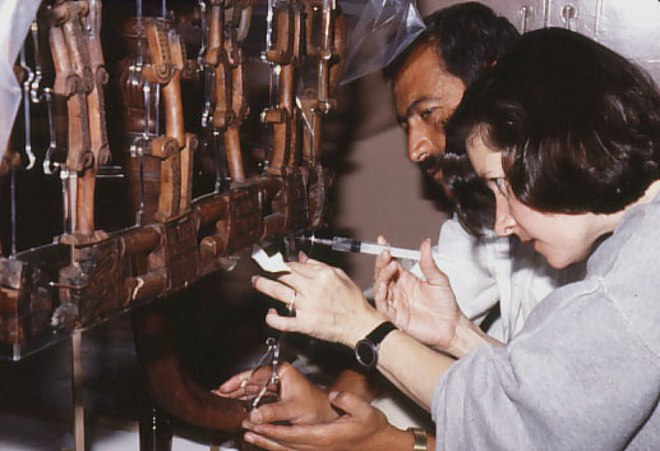
Elizabeth Simpson, professor of ancient art and archaeology, has received her third NEH grant. This new grant is a research fellowship that will allow her to complete the manuscript for her second volume on the wooden furniture and artifacts from the site of Gordion in central Turkey. The spectacular group of rare wooden objects was unearthed from the destruction level of the city mound and the royal tombs of the necropolis, dating from the eighth century BC—the period of the famous Phrygian King Midas and his predecessors. Simpson’s first volume, The Furniture from Tumulus MM, just published by Brill (2010), is a study of the furniture from the largest tumulus burial at Gordion, thought to be the tomb of Midas or his father.
Gordion was excavated between 1950 and 1973 by the University of Pennsylvania Museum, under the direction of Professor Rodney S. Young; exploration of the site by an international team continues today. Among Young’s most exciting discoveries were the organic finds, including the remains of fine textiles and an unprecedented collection of wooden objects, including carved and inlaid tables, serving stands, and stools, along with plates, bowls, spoons, boxes, a parasol, and a group of miniature carved animals—lions, bulls, a griffin, a goat, and a leaping deer. Most of these pieces came from the royal burials surrounding the city—Tumulus P, Tumulus MM, and Tumulus W; the wooden objects from the city mound are now carbonized, having been burned in the massive fire that destroyed the Phrygian capital at the height of its power in the eighth century BC.
Professor Simpson began work on the collection over 30 years ago, when she first went to Gordion to study the furniture. Young’s posthumous volume on the three royal tombs was in the process of publication, and Simpson, as Young’s student, was put in charge of the production of the volume and inking of the field drawings. During the course of her research, she found that most of the wooden objects had been drawn incorrectly and therefore misinterpreted. This was due to the condition of the wood, which was warped and damaged to a certain extent. With careful study, however, she found that the objects could be accurately rendered. Simpson began to rephotograph and redraw the objects, a long-term project that is still underway. This involved working with the original fragments, fitting the parts together where possible, in order to determine what the various objects had looked like in the eighth century BC. In order to preserve the wood, a conservation project was begun at the Museum of Anatolian Civilizations, under the auspices of the University of Pennsylvania and overseen by Simpson.
Over the course of three decades, the conservation and study of the Gordion wooden objects was carried out by a team of more than 40 conservators, scientists, archaeologists, artists, and graduate student interns, including Michelle Hargrave and Melanie Clifton-Harvey from the BGC. New storage cabinets were built in the US and shipped to the Ankara Museum for safe storage of the furniture and other objects, and special display cases were installed in the Phrygian galleries of the museum to hold some of the most important of the Gordion wooden artifacts. Now on exhibition are the fancy inlaid table and two inlaid serving stands from Tumulus MM—reconstructed on Plexiglas mounts—as well as an inlaid stool, plates, bowls, the parasol, and the small animals from Tumulus P. These and other objects from Tumulus P, a serving stand and plates from Tumulus W, and the carbonized furniture fragments from the city mound are the subject of Simpson’s volume now in progress.
“This is what I’ve been working on all this time,” says Simpson. “The first volume of the final reports on the wooden objects from Gordion has just been published. The NEH grant will allow me to write the manuscript for the second. These are very complex books, as they include hundreds of drawings and photographs, with contributions by many project participants on the conservation process, reconstruction of the pieces, and numerous scientific analyses. Indeed, it is due to the NEH and other project supporters—including the Kress Foundation, the Getty Grant Program, the National Geographic Society, the 1984 Foundation, and the Bard Graduate Center—that we have been able to save and publish these wonderful works.”
